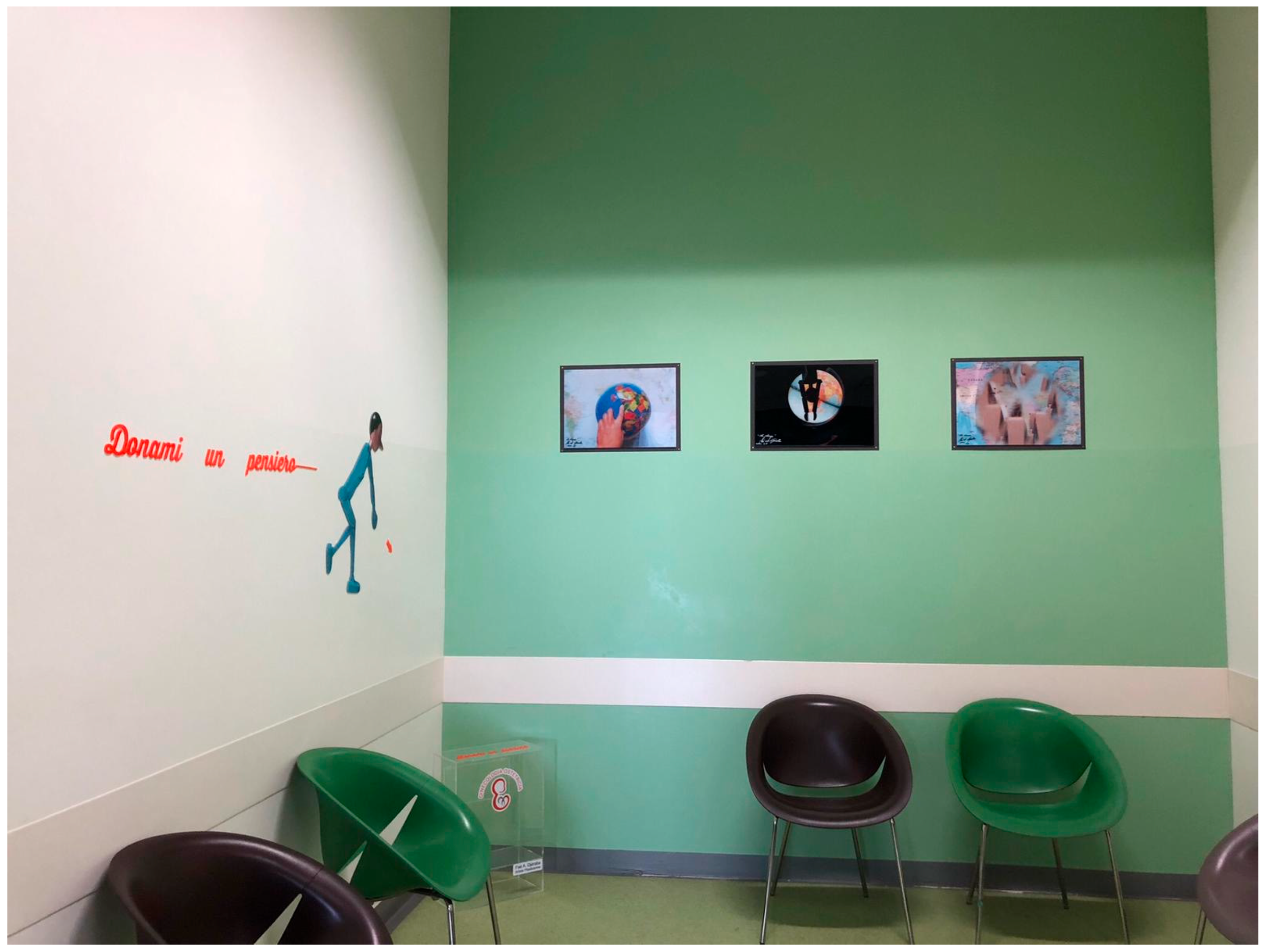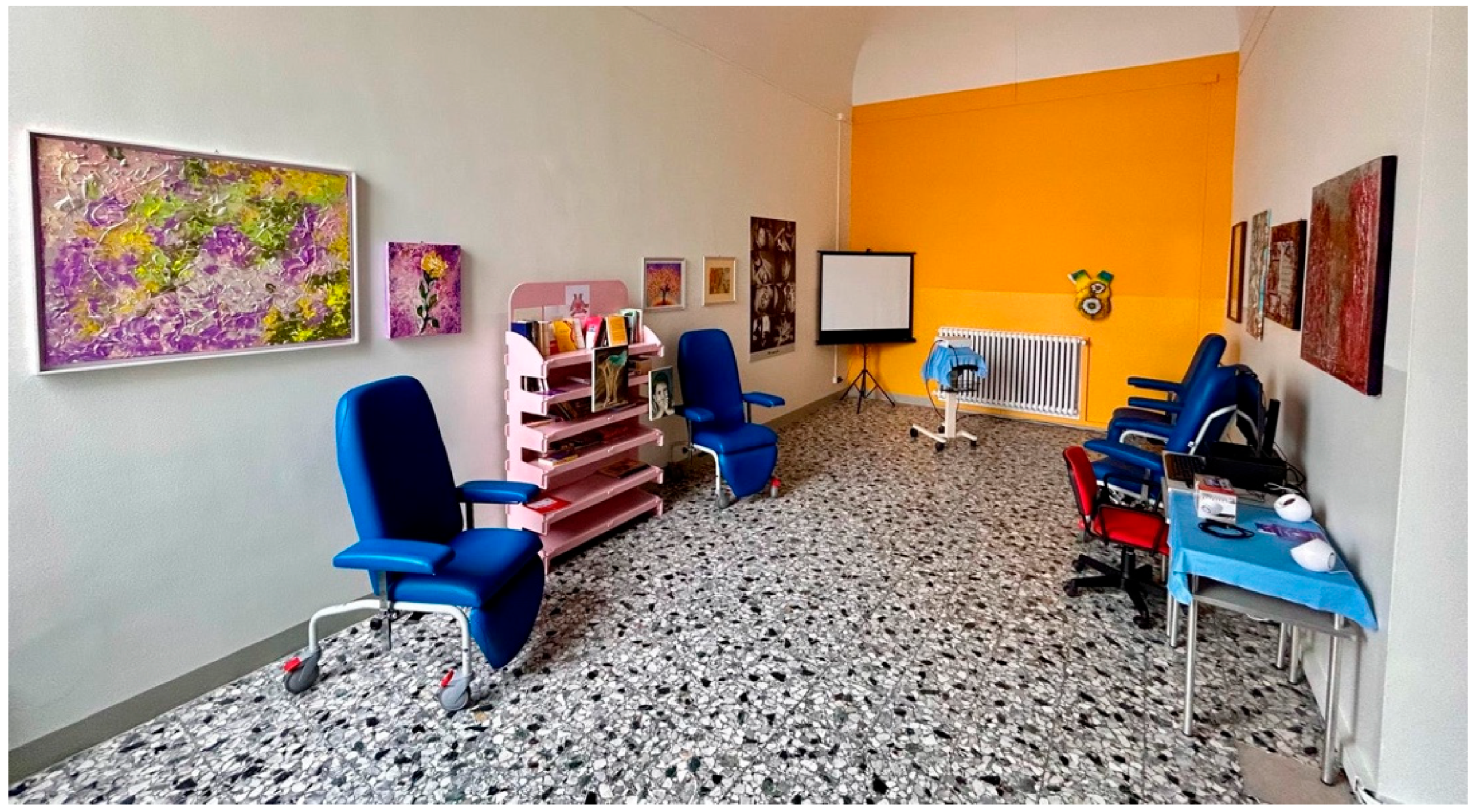The Role of Narrative Medicine and Lean Management in Umbilical Cord Blood Donation: A Story of Success
Abstract
1. Introduction
2. Materials and Methods
2.1. Study Design and Setting
2.2. Participants (Study Population)
2.3. Intervention
2.3.1. Narrative Medicine Integration
2.3.2. Lean Management Implementation
- Staff training and engagement
- Process flow mapping and optimization
- Standardization of procedures
- Continuous quality improvement
- Enhanced communication strategies
2.4. Data Collection
- Number of Donations: Number of successful donations.
- Donation Rate: Number of women who consented to donate UCB out of total births.
- Patient Satisfaction and Perceived Quality of Care: Measured via corporate satisfaction questionnaires and “PERLA–Person-Centered Care” surveys (https://www.certificazioneperla.it, accessed on 20 May 2025) in collaboration with SIMeN (Italian Society of Narrative Medicine).
- Transplant Eligibility: Proportion of collected UCB units banked for clinical use.
- Adherence Rate: Percentage of pregnant women who consented to the UCB donation during our Hospital’s Birth Pathway among the women who gave birth in our Hospital in the period July 2022–2024
2.5. Ethical Considerations
2.6. Data Analysis
3. Results
3.1. Participant Characteristics
3.2. Improvement in Donation Rates
- Pre-intervention donation rate (2007–June 2022, mean): 3.93%
- Post-intervention donation rate (July 2022–December 2022): 30.8%
- Post-intervention donation rate (2023): 25.8%
- Post-intervention donation rate (2024): 30.6%
- Donation rate during study period (July 2022–2024, mean): 29.07%
3.3. Collection and Transplant Eligibility
- -
- The medical history of the father and mother of the newborn must be known, as well as that of their respective families
- -
- No risk of transmission of genetic diseases
- -
- No positivity and/or risk of HIV and/or hepatitis
- -
- No previous travel to countries with risk of endemic diseases
- -
- No use of contraindicated medications, alcohol or drug abuse
- -
- Gestation that must have exceeded 37 weeks
- -
- Give birth in an accredited birthing center
- -
- Birth without fetal distress
3.4. Patient Satisfaction and Perceived Quality of Care
- 90.3% of patients reported feeling well-informed about UCB donation
- 88.7% indicated they felt “actively listened to” by the midwifery team
- 92.5% rated their overall care experience as “excellent” or “very good”
3.5. Operational and Organizational Improvements
- Reduction in missed donation opportunities due to more consistent patient engagement throughout the prenatal pathway
- Increased internal staff autonomy: trained in-house midwives replaced reliance on an external figure, ensuring continuity and sustainability of care and elimination of annual external grant costs (€5000) for a dedicated midwife (even if it is important to underline that we have not estimated the cost of the internal workforce)
- Shortened collection procedure times, due to smoother and standardized processes
- Increased process reliability and safety, as reported in internal observations. Staff reported greater motivation and ownership of the donation process, while delays caused by prior inefficiencies were notably reduced.
- Standardized communication protocols and training improved interdepartmental coordination and reduced delays in consent and collection logistics
3.6. Perception of Emotional and Informational Support
- Increased trust in healthcare professionals
- Greater participation in decision-making
- Enhanced perception of being welcomed and understood
4. Discussion
4.1. Integration of Humanistic and Operational Models
4.2. Comparison with National and International Data
4.3. Implications for Healthcare Delivery
4.4. Limitations
4.5. Future Directions
5. Conclusions
Author Contributions
Funding
Institutional Review Board Statement
Informed Consent Statement
Data Availability Statement
Acknowledgments
Conflicts of Interest
Abbreviations
| UCB | Umbilical cord blood |
| NM | Narrative Medicine |
| LM | Lean Management |
| SIMeN | Italian Society of Narrative Medicine |
| ADISCO | Italian Association of Female Cord Blood Donors |
References
- Zhu, X.; Tang, B.; Sun, Z. Umbilical cord blood transplantation: Still growing and improving. Stem Cells Transl. Med. 2021, 10 (Suppl. 2), S62–S74. [Google Scholar] [CrossRef] [PubMed]
- Tong, J.; Zhang, L.; Liu, H.; Xu, X.; Zheng, C.; Yao, W.; Zhu, X.; Tang, B.; Wan, X.; Song, K.; et al. Umbilical cord blood transplantation can overcome the poor prognosis of KMT2A-MLLT3 acute myeloid leukemia and can lead to good GVHD-free/relapse-free survival. Ann. Hematol. 2021, 100, 1303–1309. [Google Scholar] [CrossRef] [PubMed]
- Copeland, N.; Harris, D.; Gaballa, M.A. Human umbilical cord blood stem cells, myocardial infarction and stroke. Clin. Med. 2009, 9, 342–345. [Google Scholar] [CrossRef] [PubMed]
- Sanberg, P.R.; Eve, D.J.; Willing, A.E.; Garbuzova-Davis, S.; Tan, J.; Sanberg, C.D.; Allickson, J.G.; Cruz, L.E.; Borlongan, C.V. The treatment of neurodegenerative disorders using umbilical cord blood and menstrual blood-derived stem cells. Cell Transplant. 2011, 20, 85–94. [Google Scholar] [CrossRef] [PubMed]
- Bi, Y.; Kong, R.; Peng, Y.; Yu, H.; Zhou, Z. Umbilical cord blood and peripheral blood-derived regulatory T cells therapy: Progress in type 1 diabetes. Clin. Immunol. 2023, 255, 109716. [Google Scholar] [CrossRef] [PubMed]
- Ballen, K.K.; Verter, F.; Kurtzberg, J. Umbilical cord blood donation: Public or private? Bone Marrow Transpl. 2015, 50, 1271–1278. [Google Scholar] [CrossRef] [PubMed]
- Committee on Obstetric Practice; Committee on Genetics. ACOG committee opinion number 399, February 2008, Umbilical cord blood banking. Obstet. Gynecol. 2008, 111 Pt 1, 475–477. [Google Scholar]
- Benvenuti, M.; Cavallini, E.; Battello, G.; Zullo, F.; Driul, L.; Cromi, A.; Mannella, P.; Nappi, R.E.; Scambia, G.; De Franciscis, P.; et al. Knowledge, Attitudes, and Practices of Pregnant Women and Hospital Staff Regarding Umbilical Cord Blood Banking: Systematic Review and Meta-Analysis. Healthcare 2024, 12, 2131. [Google Scholar] [CrossRef] [PubMed]
- Herlihy, M.M.; Delpapa, E.H. Obstetricians and their role in cord blood banking: Promoting a public model. Obstet. Gynecol. 2013, 121, 851–855. [Google Scholar] [CrossRef]
- Banche del Sangue di Cordone Ombelicale Report 2023. Centro Nazionale Sangue, Ministero della Salute. Centro Nazionale Sangue Report Database. Available online: https://www.centronazionalesangue.it/rapporti-di-attivita-delle-banche-sco/#flipbook-df_18255/1/ (accessed on 20 May 2025).
- Banche del Sangue di Cordone Ombelicale Report 2022. Centro Nazionale Sangue, Ministero della Salute. Centro Nazionale Sangue Report Database. Available online: https://www.centronazionalesangue.it/wp-content/uploads/2023/04/Banche-sco-Report-2022.pdf (accessed on 20 May 2025).
- Charon, R. Narrative Medicine: Honoring the Stories of Illness, 1st ed.; Oxford University Press: Oxford, UK, 2006. [Google Scholar]
- Black, N.; Mays, N. Public inquiries into health care in the UK: A sound basis for policy-making? J. Health Serv. Res. Policy. 2013, 18, 129–131. [Google Scholar] [CrossRef]
- Bolgeo, T.; Gambalunga, F.; Di Matteo, R.; Gatti, D.; Roberti, E.; Dealberti, D.; Fadda, B.; Grassi, E.; Gambarini, L.; Iacorossi, L.; et al. Becoming a mother during the COVID-19 pandemic: The lived experience as told by birthing mothers: A qualitative study. J. Nurs. Manag. 2022, 30, 4138–4144. [Google Scholar] [CrossRef] [PubMed]
- Bacci, A. Lean Healthcare Management: Meno Sprechi, più Competitività; Wolters Kluwer: Alphen aan den Rijn, The Netherlands; IPSOA Editore: Milan, Italy, 2017. [Google Scholar]
- Boggetti, M. Pattern Comportamentali: Percorsi di Eccellenza per Guidare L’innovazione Organizzativa; Edra: Milan, Italy, 2016. [Google Scholar]
- Trenta, P. La postura Narrativa: I Modi di Essere Della Cura; Castelvecchi Editore: Roma, Italy, 2024. [Google Scholar]
- Charon, R. Narrative medicine: Caring for the sick is a work of art. JAAPA 2013, 26, 8. [Google Scholar] [CrossRef] [PubMed]
- Womack, J.P.; Jones, D.T. Lean Thinking: Banish Waste and Create Wealth in Your Corporation; Simon & Schuster: New York, NY, USA, 1996. [Google Scholar] [CrossRef]



| Year | Number of Births | Number of Donations | Donation Rate |
|---|---|---|---|
| 2007 | 1222 | 123 | 10.06% |
| 2008 | 1356 | 102 | 7.50% |
| 2009 | 1349 | 41 | 3.03% |
| 2010 | 1298 | 113 | 8.70% |
| 2011 | 1301 | 112 | 8.21% |
| 2012 | 1364 | 65 | 4.76% |
| 2013 | 1332 | 46 | 3.45% |
| 2014 | 1423 | 18 | 1.26% |
| 2015 | 1395 | 16 | 1.14% |
| 2016 | 1307 | 9 | 0.68% |
| 2017 | 1311 | 15 | 1.14% |
| 2018 | 1180 | 20 | 1.69% |
| 2019 | 1213 | 54 | 4.38% |
| 2020 | 1085 | 26 | 2.39% |
| 2021 | 1031 | 0 | 0% |
| 1 January–30 June 2022 | 516 | 0 | 0% |
| Year | Number of Births | Number of Donations | Donation Rate |
|---|---|---|---|
| 1 July–31 December 2022 | 584 | 180 | 30.8% |
| 2023 | 1046 | 270 | 25.8% |
| 2024 | 1006 | 308 | 30.6% |
| Year | Number of Units Donated | Eligible Units | Eligible Units Rate |
|---|---|---|---|
| 1 July 2022–31 December 2022 | 180 | 5 | 2.77% |
| 2023 | 270 | 15 | 5.55% |
| 2024 | 308 | 9 | 2.92% |
Disclaimer/Publisher’s Note: The statements, opinions and data contained in all publications are solely those of the individual author(s) and contributor(s) and not of MDPI and/or the editor(s). MDPI and/or the editor(s) disclaim responsibility for any injury to people or property resulting from any ideas, methods, instructions or products referred to in the content. |
© 2025 by the authors. Licensee MDPI, Basel, Switzerland. This article is an open access article distributed under the terms and conditions of the Creative Commons Attribution (CC BY) license (https://creativecommons.org/licenses/by/4.0/).
Share and Cite
Dealberti, D.; Bosoni, D.; Ghirotto, V.; Pisani, C.; Sanjinez, J.O.S.P.; Fadda, B.; Roberti, E.; Testa, M.; Stabile, G.; Dacquino, M.T. The Role of Narrative Medicine and Lean Management in Umbilical Cord Blood Donation: A Story of Success. Healthcare 2025, 13, 2567. https://doi.org/10.3390/healthcare13202567
Dealberti D, Bosoni D, Ghirotto V, Pisani C, Sanjinez JOSP, Fadda B, Roberti E, Testa M, Stabile G, Dacquino MT. The Role of Narrative Medicine and Lean Management in Umbilical Cord Blood Donation: A Story of Success. Healthcare. 2025; 13(20):2567. https://doi.org/10.3390/healthcare13202567
Chicago/Turabian StyleDealberti, Davide, David Bosoni, Valentina Ghirotto, Carla Pisani, Jeremy Oscar Smith Pezua Sanjinez, Barbara Fadda, Erica Roberti, Michela Testa, Guglielmo Stabile, and Maria Teresa Dacquino. 2025. "The Role of Narrative Medicine and Lean Management in Umbilical Cord Blood Donation: A Story of Success" Healthcare 13, no. 20: 2567. https://doi.org/10.3390/healthcare13202567
APA StyleDealberti, D., Bosoni, D., Ghirotto, V., Pisani, C., Sanjinez, J. O. S. P., Fadda, B., Roberti, E., Testa, M., Stabile, G., & Dacquino, M. T. (2025). The Role of Narrative Medicine and Lean Management in Umbilical Cord Blood Donation: A Story of Success. Healthcare, 13(20), 2567. https://doi.org/10.3390/healthcare13202567








